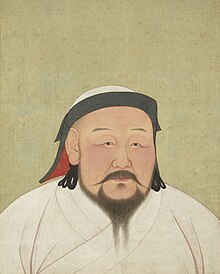| Kublai Khan | |||||||||||||||||||||
|---|---|---|---|---|---|---|---|---|---|---|---|---|---|---|---|---|---|---|---|---|---|
| Emperor of China | |||||||||||||||||||||
 Portrait by artist Araniko, drawn shortly after Kublai's death in 1294. | |||||||||||||||||||||
| Khagan of the Mongol Empire | |||||||||||||||||||||
| Reign | 5 May 1260[a] – 18 February 1294[b] | ||||||||||||||||||||
| Coronation | 5 May 1260 | ||||||||||||||||||||
| Predecessor |
| ||||||||||||||||||||
| Successor | Temür Khan | ||||||||||||||||||||
| Emperor of the Yuan dynasty | |||||||||||||||||||||
| Reign | 18 December 1271 – 18 February 1294[c] | ||||||||||||||||||||
| Successor | Temür Khan | ||||||||||||||||||||
| Born | 23 September 1215 Mongol Empire | ||||||||||||||||||||
| Died | 18 February 1294 (aged 78) Khanbaliq, Yuan dynasty | ||||||||||||||||||||
| Burial | Unknown, presumptively Burkhan Khaldun | ||||||||||||||||||||
| Empress | |||||||||||||||||||||
| Issue | Zhenjin | ||||||||||||||||||||
| |||||||||||||||||||||
| House | Borjigin | ||||||||||||||||||||
| Dynasty | Yuan | ||||||||||||||||||||
| Father | Tolui | ||||||||||||||||||||
| Mother | Sorghaghtani Beki | ||||||||||||||||||||
| Religion | Buddhism | ||||||||||||||||||||
Kublai Khan[d][e] (23 September 1215 – 18 February 1294), also known by his temple name as the Emperor Shizu of Yuan and his regnal name Setsen Khan, was the founder and first emperor of the Mongol-led Yuan dynasty of China. He proclaimed the dynastic name "Great Yuan"[f] in 1271, and ruled Yuan China until his death in 1294.
Kublai was the second son of Tolui by his chief wife Sorghaghtani Beki, and a grandson of Genghis Khan. He was almost 12 when Genghis Khan died in 1227. He had succeeded his older brother Möngke as Khagan in 1260, but had to defeat his younger brother Ariq Böke in the Toluid Civil War lasting until 1264. This episode marked the beginning of the fragmentation of the empire.[4] Kublai's real power was limited to the Yuan Empire, even though as Khagan he still influenced the Ilkhanate and, to a significantly lesser degree, the Golden Horde.[5][6][7]
In 1271, Kublai established the Yuan dynasty and formally claimed orthodox succession from prior Chinese dynasties.[8] The Yuan dynasty came to rule over most of present-day China, Mongolia, Korea, southern Siberia, and other adjacent areas. He also amassed influence in the Middle East and Europe as Khagan. By 1279, the Yuan conquest of the Song dynasty was completed and Kublai became the first non-Han emperor to rule all of China proper.
The imperial portrait of Kublai was part of an album of the portraits of Yuan emperors and empresses, now in the National Palace Museum collection in Taipei. White, the color of the imperial costume of Kublai, was the imperial color of the Yuan dynasty based on the Chinese philosophical concept of the Five Elements.[9]
Cite error: There are <ref group=lower-alpha> tags or {{efn}} templates on this page, but the references will not show without a {{reflist|group=lower-alpha}} template or {{notelist}} template (see the help page).
- ^ Robinson, David (2019). In the Shadow of the Mongol Empire: Ming China and Eurasia. Cambridge University Press. p. 50. ISBN 9781108482448. Retrieved 18 March 2022.
- ^ Robinson, David (2009). Empire's Twilight: Northeast Asia Under the Mongols. Harvard University Press. p. 293. ISBN 9780674036086. Retrieved 18 March 2022.
- ^ Brook, Timothy; Walt van Praag, Michael van; Boltjes, Miekn (2018). Sacred Mandates: Asian International Relations since Chinggis Khan. University of Chicago Press. p. 45. ISBN 9780226562933. Retrieved 18 March 2022.
- ^ Encyclopædia Britannica. p. 893.[full citation needed]
- ^ Marshall, Robert. Storm from the South: from Genghis Khan to Khubilai Khan. p. 224.
- ^ Borthwick, Mark (2007). Pacific Century. Westview Press. ISBN 978-0-8133-4355-6.
- ^ Howorth, H. H. The History of the Mongols. Vol. II. p. 288.
- ^ Kublai (18 December 1271), 《建國號詔》 [Edict to Establish the Name of the State], 《元典章》[Statutes of Yuan] (in Classical Chinese)
- ^ Chen, Yuan Julian (2014). "Legitimation Discourse and the Theory of the Five Elements in Imperial China". Journal of Song-Yuan Studies. 44 (1): 325–364. doi:10.1353/sys.2014.0000. S2CID 147099574. Retrieved 27 April 2018.